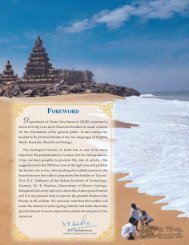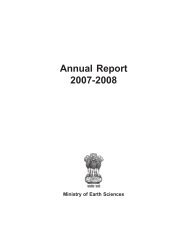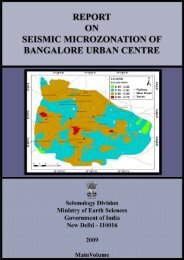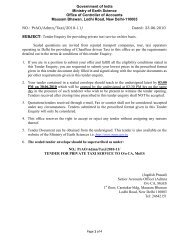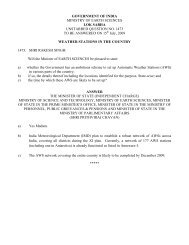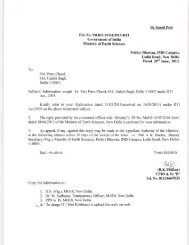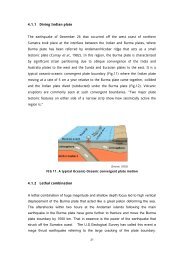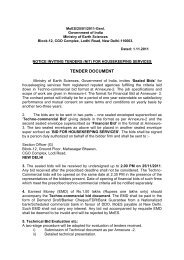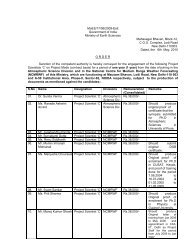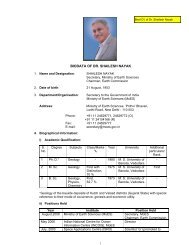Annual Report 2009-2010 - Ministry Of Earth Sciences
Annual Report 2009-2010 - Ministry Of Earth Sciences
Annual Report 2009-2010 - Ministry Of Earth Sciences
Create successful ePaper yourself
Turn your PDF publications into a flip-book with our unique Google optimized e-Paper software.
for biological studies. Moss inhabiting invertebrate<br />
fauna of the Schirmacher Oasis and terrestrial<br />
invertebrates at Larsemann Hills were studied<br />
for understanding the population dynamics of<br />
the available invertebrate fauna at some selected<br />
sites. Micro and macro fauna were studied in the<br />
Thala Fjord and the Quilty Bay and the continental<br />
shelves adjoining the proposed Indian station.<br />
Wildlife Institute of India (WII) monitored birds<br />
and mammals during the sea journey and at areas<br />
close to stations. Data such as species, location<br />
and density (number) were recorded along with<br />
data on relevant environmental variables.<br />
At the Larsemann Hills, land based surveys were<br />
carried out at the proposed site of the Indian<br />
station, the Fisher and Stornes islands, for birds<br />
and seals. Aerial surveys were carried out along the<br />
coastline from the Clements Bay to western part of<br />
the Stornes Island and at the India Bay, and aerial<br />
surveys were carried out along the ice shelf (10 ° 40’<br />
E to 13 ° 30’E) for estimating the population of seals<br />
in that stretch.<br />
During the sea journey from Cape Town to the<br />
Larsemann Hills, 36 species of birds and 6 species<br />
of mammals (hump backed whales, fin whales<br />
and others) were recorded. During the sea journey<br />
from the Larsemann Hills to the India Bay (Maitri),<br />
21 species of birds and 4 species of mammals were<br />
recorded. Significant change in the distribution<br />
and abundance of birds has been observed at<br />
different latitudes.<br />
Institute of Science undertook physiological<br />
responses on the Antarctic krill due to temperature<br />
changes. Krills were collected between 55°S and<br />
70°S. Water samples, zooplanktons and bird<br />
feathers were also collected during the voyage<br />
to and from the Larsemann Hills.<br />
4.1.1.6 Human Medicine and Physiology<br />
Defense Institute of Physiology and Allied<br />
<strong>Sciences</strong> (DIPAS) studied the effect of the Antarctic<br />
environment on the Immune Response of 28 th Indian<br />
Expedition members. It was observed that the level<br />
of cytokines of the summer expedition members<br />
were much higher on board in comparison to level<br />
at Maitri. The number of sea sick patients also<br />
increased on the way back. All the samples were<br />
carried to DIPAS lab for further analysis.<br />
4.2 29 th Indian Scientific Expedition to<br />
Antarctica<br />
4.2.1 Launching of the 29 th Expedition<br />
The year <strong>2009</strong> marked the preparation of our plans<br />
for the construction of the 3 rd Indian Research Base<br />
at the Larsemann Hills, East Antarctica. Expedition<br />
was planned and executed for putting in place<br />
the infrastructure/equipment necessary for the<br />
construction of the new station in coming years<br />
as well as for undertaking the ongoing scientific<br />
activities at the Maitri entailing the necessary<br />
logistics for maintaining the year round station.<br />
The 29 th expedition team has 53 members (30 for<br />
Summer and 23 for Winter) including 29 members<br />
for the Larsemann Hill expedition for undertaking<br />
activities related to the establishment of the<br />
3 rd Indian station. The team is drawn from IIG,<br />
CGHS, SASE, NGRI, NPL, IMD, DEAL, ITBP,<br />
NCAER, BRO, GSI, SAC, IITM, SIIRM, WII, SOI<br />
and NHO. Most of the logistic personnel of<br />
winter over team and the summer scientists, led<br />
by the expedition leader Mr. P. Elango along with<br />
necessary scientific equipment and provisions,<br />
were flown to Maitri in November <strong>2009</strong>. The<br />
Leader and the first batch of 29 th Indian Antarctic<br />
Expedition was flagged off on 5 th November,<br />
<strong>2009</strong> by Director, IIG. Scientific activities are in<br />
progress as per schedule and ground preparation<br />
for installation of Imaging Rio-meter at the Maitri<br />
site has been completed.<br />
In order to overcome the unpredictability of<br />
the extent of sea ice in space and time in the<br />
Larsemann Hill region, two ships, an Ice Breaker<br />
and a multi-purpose cargo vessel were engaged.<br />
A team of 29 members led by the voyage leader,<br />
Mr. Rajesh Asthana, was flagged off for the<br />
Larsemann Hills by the Secretary, Dr. Shailesh<br />
Nayak in Cape Town on 29 th November, <strong>2009</strong> on<br />
20 <strong>Ministry</strong> of <strong>Earth</strong> <strong>Sciences</strong> : <strong>Annual</strong> <strong>Report</strong> <strong>2009</strong>-10




